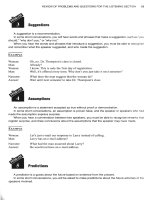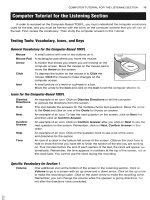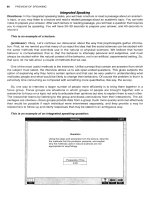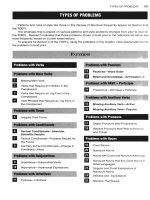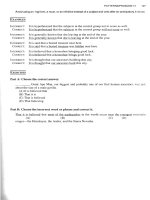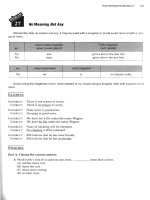Tài liệu How to prepare for the foefl part 28 docx
Bạn đang xem bản rút gọn của tài liệu. Xem và tải ngay bản đầy đủ của tài liệu tại đây (1.08 MB, 10 trang )
MODEL
TEST
1
271
Section
3:
Reading
This section measures the ability to read and understand short passages similar in topic and style to those
that students are likely to encounter in North American universities and colleges. This section contains
reading passages and questions about the passages. There are several different types of questions in this
section.
In
the Reading Section, you will first have the opportunity to read the passage. You will use the scroll bar
to view the rest of the passage.
When you have finished reading the passage, you will use the mouse to click on
Proceed.
Then the
questions about the passage will be presented. You are to choose the one best answer to each question.
Answer all questions about the information in a passage on the basis of what is stated or implied in that
passage.
Most of the questions will be multiple-choice questions. To answer these questions you will click on a
choice below the question.
To answer some questions, you will click on a word or phrase.
To answer some questions, you will click on a sentence in the passage.
To answer some questions, you will click on a square to add a sentence to the passage.
272
TOEFL
MODEL
TESTS
It has long been known that when the green
parts of plants are exposed to light under suitable
conditions of temperature and moisture, carbon
dioxide is absorbed by the plant from the
atmospheric
CO,,
and oxygen is released into the
air. This exchange of gases in plants is the
opposite of the process that occurs in respiration.
In this plant process, which is called photosynthesis,
carbohydrates are synthesized in the presence of
light from carbon dioxide and water by specialized
structures in the cytoplasm of plant cells called
chloroplasts. These chloroplasts contain not only
two types of light-trapping green chlorophyll but
also
a
vast array of protein substances called
enzymes. In most plants, the water required by
the photosynthesis process is absorbed from the
soil by the roots and translocated through the
xylem of the root and stem to the chlorophyll-laden
leaves. Except for the usually small percentage
used in respiration, the oxygen released in the
process diffuses out of the leaf into the atmosphere
through stomates. In simple terms, carbon dioxide
is the fuel, and oxygen is the product of the chemical
reaction. For each molecule of carbon dioxide
used, one molecule of oxygen is released. Here is
a summary chemical equation for photosynthesis:
6C0,
+
6H,O
C,H,,O,
+
60,
As
a result of this process, radiant energy
from the sun is stored as chemical energy. In
turn, the chemical energy is used to decompose
carbon dioxide and water. The products of their
decomposition are recombined into a new
compound, which successively builds up into
the more and more complex substances that
comprise the plant. These organic substances,
that is, the sugars, starches, and cellulose, all
belong to the class of organic molecules. In other
words, the process of photosynthesis can be
understood as an enzyme-induced chemical
change from carbon dioxide and water into the
simple sugar glucose. This carbohydrate, in turn,
is utilized by the plant to generate other forms of
energy, such as the long chains of plant cells or
polymers that comprise the cellular structures of
starches or cellulose. Many intermediate steps are
involved in the production of a simple sugar or
starch. At the same time,
a
balance of gases is
preserved in the atmosphere by the process of
photosynthesis.
1.
Which title best expresses the ideas in this
passage?
@
A
Chemical Equation
GD
The Process of Photosynthesis
03
The Parts of Vascular Plants
The Production of Sugar
2.
The combination of carbon dioxide and
water to form sugar results in an excess of
water
a
oxygen
O
carbon
a
chlorophyll
3.
Which process is the opposite of photosyn-
thesis?
@
Decomposition
Synthesization
O
Diffusion
Respiration
4.
Ln
photosynthesis, energy from the sun is
changed to chemical energy
CD
conducted from the xylem to the leaves
of green plants
O
not necessary to the process
a
released one to one for each molecule of
carbon dioxide used
MODEL
TEST
1
273
5.
Click on the sentence in paragraph
1
that
describes how oxygen is released into the
atmosphere.
Paragraph
1
is marked with an arrow
(+).
-+
It has long been known that when the green
parts of plants are exposed to light under suitable
conditions of temperature and moisture, carbon
dioxide is absorbed by the plant from the
atmospheric
CO,,
and oxygen is released into the
air. This exchange of gases in plants is the
opposite of the process that occurs in respiration.
In this plant process, which is called photosynthesis,
carbohydrates are synthesized in the presence of
light from carbon dioxide and water by specialized
structures in the cytoplasm of plant cells called
chloroplasts. These chloroplasts contain not only
two types of light-trapping green chlorophyll but
also a vast array of protein substances called
enzymes. In most plants, the water required by
the photosynthesis process is absorbed from the
soil by the roots and translocated through the
xylem of the root and stem to the chlorophyll-laden
leaves. Except for the usually small percentage
used in respiration, the oxygen released in the
process diffuses out of the leaf into the atmosphere
through stomates. In simple terms, carbon dioxide
is the fuel, and oxygen is the product of the chemical
reaction. For each molecule of carbon dioxide
6.
The word
Tf533
in paragraph
2
is closest
in meaning to
retained
converted
O
discovered
specified
_
_
-
[=cept for the usually small percentage
used in respiration, the oxygen released in the
process diffuses out of the leaf into the atmosphere
through stomates. In simple terms, carbon dioxide
is the fuel, and oxygen is the product of the chemical
reaction. For each inolecule of carbon dioxide
used, one molecule of oxygen is released. Here is
a summary chemical equation for photosynthesis:
6C02
+
6H20
-3
C6H7,O6
+
60,
As a result
of
this process, radiant energy
from the sun is stored as chemical energy. In
turn, the chemical energy is used to decompose
carbon dioxide and water. The products of their
decomposition are recombined into a new
compound, which successively builds up into
the more and more complex substances that
comprise the plant. These organic substances,
that is, the sugars, starches, and cellulose, all
belong to the class of organic molecules. In other
words, the process of photosynthesis can be
understood as an enzyme-~nduced chemical
change from carbon dioxide and water into the
simple sugar glucose. This carbohydrate, in turn,
is utilized by the plant to generate other forms of
7.
The word
theF
in paragraph
2
refers to
CD
radiant energy and chemical energy
GD
carbon dioxide and water
O
products
a
complex substances
As a result of this process, radiant energy
from the sun is stored as chemical energy. In
turn, the chemical energy is used to decompose
carbon dioxide and water. The products of their
decomposition are recombined into a new
compound, which successively builds up into
the more and more complex substances that
comprise the plant. These organic substances,
that IS, the sugars, starches, and cellulose, all
belong to the class of organic molecules. In other
words, the process of photosynthesis can be
understood as an enzyme-induced chemical
change from carbon dioxide and water into the
simple sugar glucose. This carbohydrate, in turn,
is utilized by the plant to generate other forms of
energy, such as the long chains of plant cells or
polymers that comprise the cellular structures of
starches or cellulose. Many intermediate steps are
involved in the production of a simple sugar or
starch. At the same time, a balance of gases is
preserved in the atmosphere by the process of
photosynthesis.
8.
The word
~suEce~siveT~
in paragraph
2
is
closest in meaning to
GD
with effort
GD
in a sequence
a
slowly
carefully
carbon dioxide and water. The products of their
decomposition are recombined into a new
compound, which successively builds up into
the more and more complex substances that
comprise the plant. These organic substances,
that is, the sugars, starches, and cellulose, all
belong to the class of organic molecules. In other
words, the process of photosynthesis can be
understood as an enzyme-induced chemical
change from carbon dioxide and water into the
simple sugar glucose. This carbohydrate, in turn,
is utilized by the plant to generate other forms of
energy, such as the long chains of plant cells or
polymers that comprise the cellular structures of
starches or cellulose. Many intermediate steps are
involved in the production of a simple sugar or
starch. At the same time, a balance of gases is
preserved in the atmosphere by the process of
photosynthesis.
274
TOEFL
MODEL
TESTS
9.
Besides the manufacture of food for plants,
what is another benefit of photosynthesis?
GD
It produces solar energy.
GD
It diffuses additional carbon dioxide into
the air.
O
It-maintains a balance of gases in
the
atmosphere.
a
It'removes harmful gases from
the
air.
10.
Whlch
of the following is
NOT
true of the
oxygen used in photosynthesis?
Oxygen is absorbed by the roots.
CD
Oxygen is the product of photosynthesis.
O
Oxygen is used in respiration.
OD
Oxygen is released into the atmosphere
through the leaves.
Alfred Bernhard Nobel, a Swedish inventor
and philanthropist, bequeathed most of his vast
fortune to a trust that he designated as a fund
from which annual prizes could be awarded to the
individuals and organizations that had achieved
through invention or discovery that which would
have the greatest benefit to humanity in a
particular year. According to the legend, Nobel's
death had been erroneously reported in a
newspaper, and the focus of the obituary was the
fact that Nobel had invented dynamite. He rewrote
his will in
1895,
thereby establishing, with the
original amount of nine million dollars, the Nobel
Foundation as the legal owner and administering
agent of the funds, and instituting the prizes that
are named after him. Statutes to govern the
awarding of the prizes were written, along with
guidelines for operating procedures. Five years
after Nobel's death, the first five prizes, worth
about forty thousand dollars each, were to be
awarded.
Originally the five classifications for
outstanding contributions designated in Nobel's
will included chemistry, physics, physiology or
medicine, literature, and international peace.
These prizes have been administered continually
by the Nobel Foundation in Stockholm since they
were first awarded in 1901. In 1969, a sixth prize,
for accomplishments in the field of economics and
endowed by the Central Bank of Sweden, was
added. Candidates for the prizes must be
nominated in writing by February
1
of each year
by a qualified and recognized authority in each of
the fields of competition. Recipients in physics,
chemistry, and economics are selected by the
Royal Swedish Academy, whereas recipients in
peace are chosen by the Norwegian Nobel
Committee appointed by Norway's parliament.
With the King of Sweden officiating, the prizes are
usually presented in Stockholm on December 10,
the anniversary of Nobel's death. The value,
fame, and prestige of the Nobel Prizes have
continued to grow. Today the prize includes a
medal, a diploma, and a cash award of about one
million dollars.
MODEL
TEST
1
275
11.
What does this passage mainly discuss?
e>
Alfred Bernhard Nobel
The Nobel Prizes
O
Great contributions to mankind
CD
Swedish philanthropy
12.
Why
were the prizes named for Alfred
Bernhard Nobel?
C9
He left money in his will to establish a
fund for the prizes.
He won the first Nobel Prize for his
work in philanthropy.
O
He is now living in Sweden.
He serves as chairman of the committee
to choose the recipients of the prizes.
13.
The word
V!'F
in
paragraph
1
refers to
a
Nobel's wishes
a legal document
6
a future intention
CD
a free choice
particular year. According to the legend, Nobel's
death had been erroneously reported in a
newspaper, and the focus of the obituary was the
fact that Nobel had invented dynamite. He rewrote
his
Gil
in 1895, thereby establishing, with the
original amount of nine million dollars, the Nobel
Foundation as the legal owner and administering
agent of the funds, and instituting the prizes that
are named after him. Statutes to govern the
awarding of the prizes were written, along with
guidelines for operating procedures. Five years
after Nobel's death, the first five prizes, worth
about forty thousand dollars each, were to be
awarded.
Originally the five classifications for
outstanding contributions designated in Nobel's
will included chemistry, physics, physiology or
medicine, literature, and international peace.
These prizes have been administered continually
by the Nobel Foundation in Stockholm since they
were first awarded in 1901. In 1969, a sixth prize,
for accomplishments in the field of economics and
endowed by the Central Bank of Sweden, was
added. Candidates for the orizes must
be
14.
How often are the Nobel Prizes awarded?
@
Five times
a
year
Once a year
O
Twice a year
CD
Once every two years
15.
The following sentence can be added to the
passage.
When he read this objective summary
of his life, the great chemist, it is said,
decided that he wanted his name to
be remembered for something more
positive and humanitarian than
inventing an explosive that was a
potential weapon.
Where would it best fit in the passage?
Click on the square
(W)
to add the sentence
to the passage.
Scroll
the
passage to see all of the choices.
particular year. According to the legend, Nobel's
death had been erroneously reported in a
newspaper, and the focus of the obituary was the
fact that Nobel had invented dynamite. He rewrote
his will in 1895, thereby establishing, with the
original amount of nine million dollars, the Nobel
Foundation as the legal owner and administering
agent of the funds, and instituting the prizes that
are named after him Statutes to govern the
awarding of the prizes were written, along with
guidelines for operating procedures Five years
after Nobel's death, the first five prizes, worth
about forty thousand dollars each, were to be
awarded.
=
i-,
Originally the five classifications for
outstanding contributions designated in Nobel's
will included chemistry, physics, physiology or
I
medicine, literature, and international peace.
~
I
These prizes have been administered continually
by the Nobel Foundation in Stockholm since they
i
1
were first awarded in
1901.
In 1969, a sixth prize,
1
for accomplishments in the field of economics and
~
I
endowed by the Central Bank of Sweden, was
,
8
added. Candidates for the orizes must be
276
TOEFL
MODEL TESTS
16.
The word in paragraph
2
could
best be replaced by
CO
recent
CD
unusual
O
established
a
exceptional
awarding of the prizes were written, along with
guidelines for operating procedures. Five years
after Nobel's death, the first five prizes, worth
about forty thousand dollars each, were to be
awarded.
Originally the five classifications for
*manding contributions designated in Nobel's
will included chemistry, physics, physiology or
medicine, literature, and international peace.
These prizes have been administered continually
by the Nobel Foundation in Stockholm since they
were first awarded in 1901. In 1969, a sixth prize,
for accomplishments in the field of economics and
endowed by the Central Bank of Sweden, was
added. Candidates for the prizes must be
nominated in writing by February
1
of each year
by a qualified and recognized authority in each of
the fields of competition. Recipients in physics,
chemistry, and economics are selected by the
Royal Swedish Academy, whereas recipients in
peace are chosen by the Norwegian Nobel
Committee appointed by Norway's parliament.
With the King of Sweden officiating, the prizes are
usually presented in Stockholm on December
10,
17.
A
Nobel Prize would NOT be given to
GD
an author who wrote a novel
a
a doctor who discovered a vaccine
O
a composer who wrote a symphony
CD
a
diplomat who negotiated a peace
settlement
18.
What does the author mean by the statement
continually by the
Nobel
Foundation
ET
Stockholm since they were first awardem
1901
?
GD
The Nobel Foundation oversees the
management of the money and the
distribution of the prizes.
QD
The Nobel Foundation selects the
recipients of the prizes.
O
The Nobel Foundation solicits applica-
tions and recommendations for the prizes.
CD
The Nobel Foundation recommends
new prize classifications.
(Orlalnalivthefive
ciassifications for
PY
outstaniing contributions designated in Nobel's
will included chemistry, physics, physiology or
medicine, literature, and international peace.
these
prizes~haveb'ee'n-administere8continG5l@
by the Nobel Foundation in Stockholm since they
were first awarded in 1901. In 1969, a sixth prize,
for accomplishments in the field of economics and
endowed by the Central Bank of Sweden, was
added. Candidates for the prizes must be
nominated in writing by February 1 of each year
by a qualified and recognized authority in each of
the fields of competition. Recipients in physics,
chemistry, and economics are selected by the
Royal Swedish Academy, whereas recipients in
peace are chosen by the Norwegian Nobel
Committee appointed by Norway's parliament.
With the King of Sweden officiating, the prizes are
usually presented in Stockholm on December 10,
the anniversary of Nobel's death. The value,
fame, and prestige of the Nobel Prizes have
continued to grow. Today the prize includes a
medal, a diploma, and a cash award of about one
million dollars.
MODEL
TEST
1
277
19.
Why are the awards presented on December
1
O?
a
It is a tribute to the King of Sweden.
a
Alfred Bernhard Nobel died on that day.
O
That
date was established in Alfred
Nobel's will.
The Central Bank of Sweden
administers the trust.
20.
Look at the word in
the
passage.
Click'on the word
or
phrase in the
bold
text
that is closest in meaning to
m.
by a qualified and recognized authority in each of
the fields of competition. Recipients in phys~cs,
chemistry, and economics are selected by the
Royal Swedish Academy, whereas recipients in
peace are chosen by the Norwegian Nobel
Committee appointed by Norway's parliament.
With the King of Sweden officiating, the prizes are
usually presented in Stockholm on December
10,
the anniversary of Nobel's death.The value,
tame, and prestige of the Nobel Prizes have
continued to grow. Today the prlze includes a
medal,
a
diploma, and a cash award of about one
million dollars.
Although stage plays have been set to music
since the era of the ancient Greeks, when the
dramas of Sophocles and Aeschylus were
accompanied by lyres and flutes, the usually
accepted date for the beginning of opera as we
know it is 1600. As a part of the celebration of the
marriage of King Henry IV of France to the ltalian
aristocrat Maria de Medici, the Florentine
composer Jacopo Pen' produced his famous
Euridice,
generally considered to be the first
opera. Following his example, a group of ltalian
musicians, poets, and noblemen called the
Carnerata began to revive the style of musical
story that had been used in Greek tragedy. The
Camerata took most of the plots for their operas
from Greek and Roman history and mythology,
beginning the process of creating an opera by
writing a libretto or drama that could be used to
establish the framework for the music. They called
their compositions
opera
in
musica
or musical
works. It is from this phrase that the word "opera"
was borrowed and abbreviated.
For several years, the center of opera was
Florence in northern Italy, but gradually, during the
baroque period, it spread throughout Italy. By the
late 1600s, operas were being written and
performed in many places throughout Europe,
especially in England, France, and Germany.
However, for many years, the ltalian opera was
considered the ideal, and many non-Italian
composers continued to use ltalian librettos. The
European form deemphasized the dramatic
aspect of the ltalian model. New orchestral effects
and even ballet were introduced under the guise
of opera. Composers gave in to the demands of
singers, writing many operas that were little more
than a succession of brilliant tricks for the voice,
designed to showcase the splendid voices of the
singers who had requested them. It was thus that
complicated arias, recitatives, and duets evolved.
The aria, which is a long solo, may be compared
to a song in which the characters express their
thoughts and feelings. The recitative, which is also
a solo of sorts, is a recitation set to music, the
purpose of which is to continue the story line. The
duet is a musical piece written for two voices, a
musical device that may serve the function of
either an aria or a recitative within the opera.
278
TOEFL
MODEL
TESTS
21.
This passage is a summary of
opera in Italy
GD
the Camerata
O
the development of opera
OD
Euridice
22.
Look at the word in the passage.
Click on the word or phrase in the
bold
text
that is closest in meaning to
m.
23.
According to this passage, when
did
modern
opera begin?
Although stage plays have been set to music
since the era of the ancient Greeks, when the
dramas of Sophocles and Aeschylus were
accompanied by lyres and flutes, the usuaw
In the time of the ancient Greeks
CD
In the fifteenth century
O
At the beginning of the sixteenth
century
OD
At the beginning of the seventeenth
century
accepted date for the beginning of opera as we
know it is
1600.
As a part of the celebration of the
marriage of King Henry IV of France to the ltalian
aristocrat Maria de Medici, the Florentine
composer Jacopo Pen produced his famous
Eutidice,
generally considered to be the first
opera. Following his example, a group of ltalian
musicians, poets, and noblemen called the
Camerata began to revive the style of musical
story that had been used in Greek tragedy. The
Camerata took most of the plots for their operas
from Greek and Roman history and mythology,
beginning the process of creating an opera by
writing a libretto or drama that could be used to
establish the framework
for
the music.They called
their compositions
opera
in
rnusica
or musical
works. It is from this phrase that the word "operan was
borrowed and abbreviated.
For several years, the center of opera was
Florence in northern ftaly, but gradually, during the
24.
The word in paragraph
1
refers to
-:,.
:,
-$
,
'-
,&
,.)~
1'
.A;:
.L:
,
.
;.>
I
'i
.C
a
opera
a
date
O
era
a
music
Although stage plays have been set to music
since the era of the ancient Greeks, when the
dramas of Sophocles and Aeschylus were
accompanied by lyres and flutes, the usually
accepted date for the beginning of opera as we
know it is
1600.
As a part of the celebration of the
marriage of King Henry IV of France to the ltalian
aristocrat Maria de Medici, the Florentine
composer Jacopo Peri produced his famous
Euridice, generally considered to be the first
opera. Following his example, a group of ltalian
musicians, poets, and noblemen called the
Camerata began to revive the style of musical
story that had been used in Greek tragedy. The
Camerata took most of the plots for their operas
from Greek and Roman history and mythology,
beginning the process of creating an opera by
writing a libretto or drama that could be used to
establish the framework for the music. They called
their compositions
opera
in musica
or musical
works. It is from this phrase that the word "cpera" was
borrowed and abbreviated.
For several years, the center of opera was
Florence in northern Italy, but gradually, during the
25.
According to the author, what
did
Jacopo
Peri write?
GD
Greek tragedy
CD
The first opera
O
The opera
Maria de Medici
OD
The opera
The Camerata
26.
The author suggests that
Euridice
was
produced
GD
in
France
CD
originally by Sophocles and Aeschylus
O
without much success
a
for the wedding of King Henry IV
27.
What was the Camerata?
a
A
group of Greek musicians
CD
Musicians who developed
a
new
musi-
cal drama based upon Greek drama
O
A
style of music not known in Italy
a
The name given to the court of King
Henry
IV
28.
The word in paragraph
1
could best
be replaced by
appreciate
resume
modify
investigate
MODEL
TEST
1
279
29. The
word in paragraph
1
is closest in
meaning to
locations
OD
instruments
O
stories
CD
inspiration
Although stage plays have been set to music
since the era of the anclent Greeks, when the
dramas of Sophocles and Aeschylus were
accompanied by lyres and flutes, the usually
accepted date for the beginning of opera as we
know it is 1600. As a part of the celebration of the
marrlage of King Henry IV of France to the ltalian
aristocrat Maria de Medici, the Florentine
composer Jacopo Peri produced his famous
Euridice, generally considered to. be the first
opera. Following his example, a group of ltalian
musicians, poets, and noblemen called the
Camerata began to reme the style of musical
story that had been used in Greek tragedy. The
Camerata took most of the plots for their operas
from Greek and Roman history and mythology,
beginning the process of creating an opera by
writing a libretto or drama that could be used to
establish the framework for the music. They called
their compositions opera
in
musica or musical
works. It is from this phrase that the word "opera" was
borrowed and abbrev~ated.
For several years, the center of opera was
Florence in northern Italy, but gradually, during the
know it is 1600. As a part of the celebration
of
the
marriage of King Henry IV of France to the ltalian
aristocrat Maria de Medici, the Florentine
composer Jacopo Peri produced his famous
Euridice,
generally considered to be the first
opera. Following his example, a group of ltalian
musicians, poets, and noblemen called the
Camerata began to revive the style of musical
story that had been used in Greek tragedy.The
I
Camerata took most of the plots for their operas
from Greek and Roman history and mythology,
beginning the process of creating an opera by
writing a libretto or drama that could be used to
establish the framework for the music. They called
their compositions
opera
in
musica
or musical
works. It is from this phrase that the word "opera" was
borrowed and abbreviated.
For several years, the center of opera was
Florence in northern Italy, but gradually, during the
baroque penod, it spread throughout Italy. By the
late 1600s, operas were being written and
performed in many places throughout Europe,
especially in England, France, and Germany.
However, for many years, the ltalian opera was
30.
From what did the term "opera" derive?
Greek and Roman history and
mythology
GD
Non-Italian composers
O
The Italian phrase that means "musical
works"
CD
The ideas of composer Jacopo
Pen
280
TOEFL
MODEL TESTS
3
1.
Look at the word
TZ?ii'
in
the passage.
Click on the word or phrase in the
bold
text
that refers to.
However, for many years, the Italian opera was
considered the ideal, and many non-Italian
composers continued to use Italian librettos. The
European form deemphasized the dramatic
aspect of the Italian model.
New
orchestral effects
and even ballet were introduced under the guise
of opera. Composers gave in to the demands of
singers, writing many operas that were little more
than a succession of brilliant tricks for the voice,
designed to showcase the splendid voices of the
singers who had requested them. It was thus that
complicated arias, recitatives, and duets evolved.
The aria, which is a long solo, may be compared
to a song in which the characters express their
thoughts and feelings. The recitative, which is also
a solo of sorts, is a recitation set to music, the
purpose of which is to continue the story line. The
duet is a musical piece written for two voices, a
musical device that may serve the function of
either an aria or a recitative within the opera.
32.
Look at the
word
T3VT8ff
in the passage.
Click on the word or phrase in the
bold
text
that is closest in meaning to
aspect of the Itallan model. New orchestral effects
and even ballet were ~ntroduced under the guise
of opera. Composers gave in to the demands of
singers, wr~ting many operas that were little more
than a succession of brilliant tricks for the voice,
designed to showcase the splendid voices of the
slngers who had requested them. It was thus that
complicated arias, recitatives, and duets evolved.
The aria, which is
a
long solo, may be compared
to a song in which the characters express their
thoughts and feelings.The recitative, which is also
a solo of sorts, is a recitation set to music, the
purpose of which is to continue the story line.The
duet is a musical piece written for two voices,
a
musical device that may serve the funktion of
either an aria or a recitative within the opera.
According to the controversial sunspot theory,
great storms or eruptions on the surface of the
sun hurl streams of solar particles into space and
eventually into the atmosphere of our planet, causing
shifts in the weather on the Earth and interference
with radio and television communications.
A typical sunspot consists of a dark central
umbra, a word derived from the Latin word for
shadow, which is surrounded by a lighter penumbra
of light and dark threads extending out from the
center like the spokes of a wheel. Actually, the
sunspots are mler than the rest of the photosphere,
which may account for their apparently darker
color. Typically, the temperature in a sunspot
umbra is about 4000
K,
whereas the temperature
in a penumbra registers 5500
K,
and the granules
outside the spot are 6000
K.
Sunspots range in size from tiny granules to
complex structures with areas stretching for
billions of square miles. About
5
percent of all
sunspots are large enough so that they can
be seen from Earth without instruments;
consequently, observations of sunspots have
been recorded for thousands of years.
Sunspots have been observed in
arrangements of one to more than one hundred
spots, but they tend to occur in pairs. There is also
a marked tendency for the two spots of a pair to
have opposite magnetic polarities. Furthermore,
the strength of the magnetic field associated with
any given sunspot is closely related to the spot's
size. Sunspots have also been observed to occur
in cycles, over a period of eleven years. At the
beginning of a cycle, the storms occur between 20
and 40 degrees north and south of the equator on
the sun. As the cycle continues, some of the
storms move closer to the equator. As the cycle
diminishes, the number of sunspots decreases to
a minimum and they cluster between
5
and
15
degrees north and south latitude.
Although there is no theory that completely
explains the nature and function of sunspots,
several models show scientists' attempts to relate
the phenomenon to magnetic field lines along the
lines of longitude from the north and south poles
of the sun.
